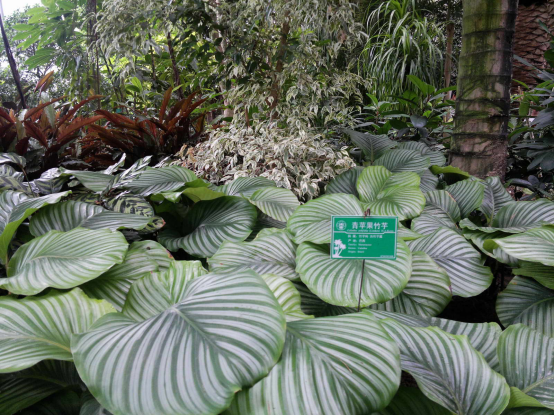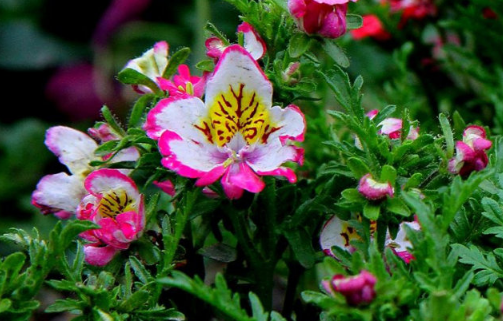Propagation of round-leaf taro
Ramet propagation
Ramet propagation is the most common way of propagation of round-leaf taro. When the temperature is about 20 ℃, it is the most suitable to divide the plant, but if the temperature and humidity are suitable, it can also be propagated throughout the year.
When propagating, we first cut open the root mass with stems, leaves and leaf buds, but if we are carrying out a small amount of propagation, we can put the cut root block in the flowerpot; if we are carrying out mass propagation, we should put it on the seedbed; when the temperature and humidity are not suitable, we should use the film cover; the temperature in the film must be controlled between 20 and 28 ℃, and the humidity must be controlled above 80%.
Cuttage propagation
Cutting propagation needless to say, the platitudes of reproduction techniques, if in doubt, you can watch the previous article push oh. However, we should note that the cuttage survival rate of round-leaf taro is not as good as split propagation, and the general survival rate is about 50%.

So much for the two ways of reproduction of round-leaf taro. Next, let's take a look at its pest control.
Propagation mode of round-leaf taro
Ramet propagation of round-leaf taro
The propagation mode of round-leaf taro is generally divided into individual plants, and the temperature in spring is about 20 ℃. It is best to split plants at this time, as long as the temperature and humidity are suitable, they can reproduce all the year round.
When propagating, use a sharp blade to cut the root block with stem leaves or leaf buds; if it is propagated in a small amount, the root block with stem leaves or leaf buds can be placed directly in the flowerpot; if it is propagated in large numbers, it should be placed on the seedbed; when the temperature and humidity do not meet the requirements, it should be covered with a thin film; the temperature in the film must reach 20 to 28 ℃, and the humidity should be above 80%.
Cutting Propagation of Amorphophallus rotundus
Cuttings are propagated with top tender shoots, the cuttings are 10 to 15 cm long, and 1/3 or 1/2 leaves are retained depending on the size of the leaves. Cuttings are treated with 500ppm's neoacetic acid for 2 to 3 seconds, or with indole acetic acid and ABT rooting powder. After the cuttings were treated, the cuttings were inserted on the seedbed with a row spacing of 5 cm by 10 cm. The panicle was covered with a thin film bow shed, and the management method was the same as ramet propagation. Cutting propagation can be carried out at any time when the temperature is not less than 20 degrees. Cuttings take root in 30 to 50 days, but the survival rate of cuttings is not as high as that of ramet propagation, and the general survival rate is about 50%.
The main propagation method of round-leaf taro is introduced to you by Xiaobian. Round-leaf taro is suitable for home decoration and beautification or greening. Can be placed in a brighter room for viewing.
Is round-leaf taro poisonous? can families raise round-leaf taro?
Round-leaf taro is a kind of plant that likes shade and is not resistant to high temperature and exposure. After it was introduced into our country, it can be seen in many places in the country. Many people's understanding of round-leaf taro is not very clear, and some people even say that it is as toxic as plants such as daffodils. So what is the truth?
Is round-leaf taro poisonous?
There are many classifications below the bamboo taro family, so we cannot generalize that any bamboo taro family is poisonous. After modern scientific research, there is no evidence that it is toxic, so at present, round-leaf taro should not be toxic. So when we deal with the juice of round-leaf taro, we don't have to be so frightened and can be relatively calm.
Can families raise round-leaf taro?
Families can raise round-leaf taro, and there are certain benefits after breeding, mainly in the following points:
1. Ornamental function: considering that the leaf color of round-leaf taro is gorgeous, and it is a shady plant, the cultivation and management of round-leaf taro is relatively simple, so it is widely used in indoor pot culture. Indoors, due to the colorful leaves of round-leaf taro, it is high-grade and can be directly used as a leaf-cutting raw material for flower arrangement.
2, decorative function: as one of the most famous indoor household plants in the world, round-leaf taro can be used in the remote corner of the hotel for permanent decoration, but also can decorate the bedroom at home. Remember that in the process of cultivating round-leaf taro, every time we put it indoors, we should put it on the balcony for a period of time to facilitate the long-term viewing of round-leaf taro.
3. Greening value: although the formaldehyde removal capacity of round-leaf taro is 1/2 of that of Cymbidium, it is much more efficient than other ordinary plants and can purify the air. In addition, round-leaf taro is also a master of ammonia removal.
Propagation methods of round-leaf taro
First, separate plant propagation.
The main results are as follows: 1. The propagation mode of round-leaf taro is generally divided into plants. the temperature in spring is about 20 ℃, and it is best to split at this time. As long as the temperature and humidity are suitable, it can reproduce all the year round.
When propagating, use a sharp blade to cut the root block with stem leaves or leaf buds; if it is propagated in a small amount, the root block with stem leaves or leaf buds can be placed directly in the flowerpot; if it is propagated in large numbers, it should be placed on the seedbed; when the temperature and humidity do not meet the requirements, it should be covered with a thin film; the temperature in the film must reach 20 to 28 ℃, and the humidity should be above 80%.
Second, cuttage propagation.
1. Cuttings are propagated with top shoots. The cuttings are 10 to 15 centimeters long and retain 1/3 or 1/2 leaves depending on the size of the leaves.
2. The cuttings were treated with 500ppm NAA for 2 to 3 seconds, or with indole acetic acid and ABT rooting powder.
3. After the cuttings were treated, the cuttings were inserted on the seedling bed, and the row spacing was 5 cm by 10 cm. The panicle was covered with a thin film bow shed, and the management method was the same as ramet propagation. Cutting propagation can be carried out at any time when the temperature is not less than 20 degrees. Cuttings take root in 30 to 50 days, but the survival rate of cuttings is not as high as that of ramet propagation, and the general survival rate is about 50%.
Which plants are poisonous and not suitable for domestic cultivation
Poinsettia. The whole plant is poisonous, especially the white juice in the stems and leaves can irritate the skin and cause allergic reactions, such as accidental ingestion of stems and leaves, which is at risk of poisoning and death.
2. Yu Mei. The whole plant is poisonous and contains toxic alkaloids, especially the fruit is the most toxic, if eaten by mistake, it will cause central nervous system poisoning, serious may also lead to life-threatening.
3. Oleander. Blooming in spring, summer and autumn every year, it is a kind of flower that can not only watch and cure, but also make people poisoned. Its stems, leaves and even flowers are poisonous, and its smell, if smelled for too long, will make people drowsy and intellectual decline. The milky white juice it secretes can be poisoned if eaten by mistake.
Round-leaf taro is not only non-toxic, but also very suitable for breeding at home, because it has a certain role in purifying the air. It is said that people should not listen to rumors in the future. When raising at home, it can be propagated by ramet and cuttage, which can make it grow better.
- Prev

How to raise moths and butterflies
Potted soil selection of moth butterfly flower is also fastidious when planting, the flowerpot had better choose 10-15 cm, when transplanting seedlings, we should remember to carry soil at the root of the plant, and the soil should be loose, breathable, fertile and well drained. This kind of soil, we can arrange it according to the proportion, if we think it's too troublesome.
- Next

Matters needing attention in the culture of moth, butterfly and flower
Pruning the moth butterfly flower in the process of its growth, it should be pruned frequently in order to keep the plant beautiful. When the plant is transplanted into the pot, it is necessary to pick the heart of the plant once, so that it can separate more new branches, and then, in order to maintain the ornamental nature of the plant, the plant can be pruned many times.
Related
- Fuxing push coffee new agricultural production and marketing class: lack of small-scale processing plants
- Jujube rice field leisure farm deep ploughing Yilan for five years to create a space for organic food and play
- Nongyu Farm-A trial of organic papaya for brave women with advanced technology
- Four points for attention in the prevention and control of diseases and insect pests of edible fungi
- How to add nutrient solution to Edible Fungi
- Is there any good way to control edible fungus mites?
- Open Inoculation Technology of Edible Fungi
- Is there any clever way to use fertilizer for edible fungus in winter?
- What agents are used to kill the pathogens of edible fungi in the mushroom shed?
- Rapid drying of Edible Fungi

